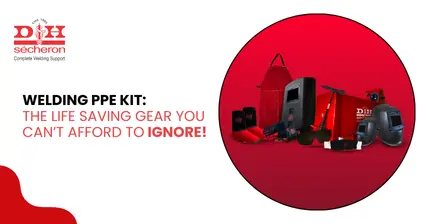Understanding the Types of Welding Wires and Their Applications
Introduction
Welding involves joining materials, typically metals, using heat to create a strong, durable bond. While skilled welders play a crucial role, the choice of welding wire is equally important. Let’s explore how different welding wires are designed for specific applications, understand their types and their applications since these can make a significant difference in the quality and integrity of the weld.
MIG Wire Types:
Metal Inert Gas welding, is known for its versatility and efficiency and come in various types:
1. Solid Wire: Solid MIG wires are used with a shielding gas to protect the weld area from atmospheric contamination. These wires are suitable for welding materials like steel, stainless steel, and aluminium. Solid wires produce clean, aesthetically pleasing welds.
2. Flux-Cored Wire: A type of MIG wire that contains a core filled with flux materials. These wires are ideal for welding in less-than-ideal conditions, as the flux creates a shielding gas when melted. Best for thicker materials and outdoor welding where wind and environmental factors can affect the shielding gas.
3. Dual-Shield Wire: Dual-shield wires combine the benefits of both solid and flux-cored wires. They have a solid metal exterior and a flux core, offering good penetration and weld quality. These wires are ideal for welding heavy and high-stress materials.
Welding Material and Its Impact:
The material you intend to weld has a significant impact on the choice of welding wire. Different materials have varying melting points and compositions, making it crucial to select the right welding wire for the job.
1. Steel: Solid wire with a shielding gas is suitable for mildly thick stainless steel, while flux-cored wire is excellent for thicker steel or when outdoor conditions make gas shielding challenging.
2. Aluminium: Welding aluminium requires a specialized approach. Aluminium MIG wires are softer and more flexible than steel wires to accommodate the material's unique properties.
3. Stainless Steel: Stainless steel welding demands the use of specialized stainless steel MIG wires that prevent contamination and ensure a clean, corrosion-resistant weld.
4. Copper and Brass: For copper and brass materials, you'll need to choose the appropriate MIG wire to ensure a strong and durable weld without impurities.
Flux Core Wire:
Flux-cored wire has self-shielding capabilities that generates a protective atmosphere, making it a versatile option that is useful for applications involving welding materials with surface contaminants, as the flux can clean the weld during the process.
Flux-cored wire is used in construction, shipbuilding, and structural fabrication or for applications involving thicker materials and heavy-duty projects.
Conclusion:
Understanding the different types of welding wires and their applications is crucial for achieving high-quality welds. The choice of welding wire should be based on the materials you're working with, the environmental conditions, and the specific requirements of the project.
When it comes to selecting the right welding wire for your projects, D&H Sécheron stands out as a trusted and industry-leading choice. With a wide range of welding wires that cater to various materials and applications, D&H Sécheron provides the quality and expertise you need for successful welding.
11 May 2025 | Welding
An In-Depth Exploration of Low-Alloy Steel: Your Comprehensive Guide
11 May 2025 | Welding
Nagpur - Bori - Tuljapur Road MSH-3 in Yavatmal District (Maharashtra)
11 May 2025 | Welding
Guidelines to Understand Gas Welding: Applications, Advantages & Disadvantages
11 May 2025 | Welding
3 Tips for Finding the Best Mild Steel Electrode for Your Application
11 May 2025 | Welding
How to Select the Right Welding Filler Wires for Stainless Steel Welding?
11 May 2025 | Welding
Building the Narendra Modi Stadium with Norma V and Autotherme-1 Electrodes
11 May 2025 | Welding
Low Alloy Steel Welding in a (PEB) Pre Engineered Building Structure
11 May 2025 | Welding
Welding Rods: Different Types and Tips for Properly Storing and Handling
11 May 2025 | Welding
Tips for Flawless Welds with Stainless Steel Electrodes: Pros and Cons
11 May 2025 | Welding
Exploring Applications and Benefits of Stainless Steel Welding Electrodes
11 May 2025 | Welding
Welding Basics: Joining Metals with Heat and Pressure - A Beginners Guide
11 May 2025 | Welding
Distinguishing Low-Alloy Steel from High-Alloy Steel: Understanding the Variations
11 May 2025 | Welding
Hard Facing Wire - Understanding the Process and Achieving Optimal Result
11 May 2025 | Welding
Exploring the Advantages of Stainless Steel Electrodes in Welding Applications
11 May 2025 | Welding
Weathering Steel vs. Traditional Steel: A Comparative Analysis of Performance
11 May 2025 | Welding
Choosing the Right Welding Rod: Why 6013 Electrodes Might Be Your Ideal Option
11 May 2025 | Welding
Why 7018 Electrodes Are Preferred for High-Strength Welds in Pipeline Construction
11 May 2025 | Welding
Filler Wire vs. Stainless Steel Filler Wire: Understanding the Key Differences
11 May 2025 | Welding
Exploring the Impact of Filler Material on Welding Quality and Durability
11 May 2025 | Welding
Choosing the Right Cast Iron Electrode for Different Welding Projects
11 May 2025 | Welding
Top Advantages of Cast Iron Electrodes for Industrial Welding Applications
11 May 2025 | Welding
Key Benefits and Challenges of Using TIG Welding in Industrial Projects
11 May 2025 | Welding
5 Reasons Why 7018 Electrode is the Gold Standard for Welding Professionals
11 May 2025 | Welding
Top 5 Advantages of Flux Cored Arc Welding for Heavy-Duty Applications.png)
11 May 2025 | Welding
Lotherme-601: A Game-Changer for Restoring Shoulder Pins in Heavy Machinery
11 May 2025 | Welding
How D&H Sécheron Helped Repair a Rotary Kiln’s Cooler Section with LoTherme 352
11 May 2025 | Welding
Piston Repair for Mining Industry: Cost-Effective Solutions with LoTherme 468.webp)






.jpg)








































.jpg)
.jpg)

.jpg)

.jpg)




.jpg)
.jpg)
.jpg)



.webp)
.jpg)
.jpg)
.webp)
.jpg)






















.png)



.webp)

.webp)
.webp)



